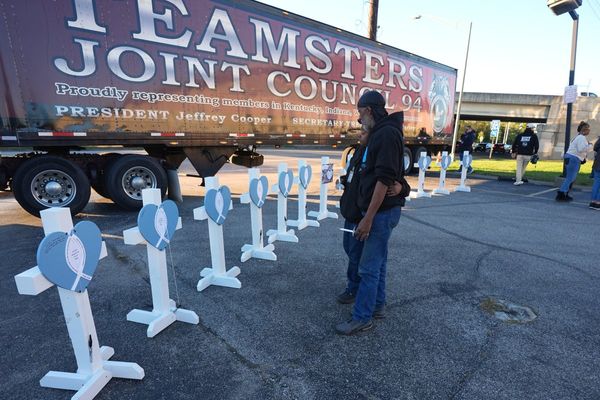
France could well be the perfect place to track the progress of the main battle over the future of travel: trains versus planes. In May 2021, France positioned itself as the frontrunner in a carbon-cutting train renaissance when its government enacted a ban on domestic flights where the journey could be done by train in less than two and a half hours. “We are the first to do it,” Emmanuel Macron said on Twitter, and it was hailed by minister Clément Beaune as a “powerful message” and a “strong symbol”. The European Commission designated 2021 as the “Year of European Rail” and billions of euros have since poured into railway infrastructure across central and eastern Europe.
So as the summer holidays began, a heatwave rose and nationwide strikes loomed, I bought a “one country” Interrail pass for £201 and set off on a circular loop round France by train, to see whether Macron’s policy was visionary policy or a pipe dream that discounted the strain it would put on crumbling public infrastructure. The 18-day route I’d plotted used trains from high-speed TGVs to rickety regional TERs, blending major cities with small towns. Arriving on the Eurostar in Paris, I’d head west towards Nantes, down the Atlantic coast to Bordeaux and seaside resort Soulac-sur-Mer, across the south to Narbonne and Marseille, before heading across country to the ancient volcanic region of Chaîne des Puys, before returning to Paris.
Paris to Nantes was a peaceful and direct high-speed TGV for four hours and 16 minutes. The buffet car was remarkably classy, offering the usual fare alongside small jars of honey and four types of tea. Both were a bit pricey for me, but I was glad they were there. The train pulled into Nantes at sunset, and the city had an excitable hum. Each summer, the streets are filled with free public art, and a green line painted on the ground guides visitors from piece to piece. Traffic noise is absent thanks to an electrified tram system and large pedestrianised zones, allowing alfresco bars and restaurants to spill on to the roads. At night, all you can hear is the warm sound of voices.
A few days later, my four-hour journey to Soulac-sur-Mer on the silver coast of Aquitaine started on Intercités, the medium- to long-distance trains that run where there are no TGVs. If there was wifi onboard, it wasn’t working, and as there was very little phone reception, I spent the time staring out of the window at fields of corn and sunflowers, rigidly rowed vineyards and thick green streams. At Bordeaux Saint-Jean, the atmosphere was frantic as thousands of people funnelled into low-ceiling tunnels in search of connections. Mine was a battered TER train, its inside shrouded in darkness as every window was sprayed thickly in graffiti. But the aircon was working and it felt like an angel’s breath.

If France has a climate crisis frontline, it is in places like Soulac-sur-Mer. In 1967, a four-storey block of holiday flats, named Le Signal, was built 200 metres from the water, offering panoramic views of the Atlantic. But rising sea levels accelerated by climate change saw the ocean creep closer and closer, eating up the metres each year. By 2014, the 75 flats of Le Signal had to be evacuated. In February this year, the abandoned block was finally demolished. I walked to where it had stood – now a sand dune being slowly repopulated by tufts of marram grass.
To get to my next stop, Narbonne, I headed back to Bordeaux and changed on to an Intercités train for a three and a half-hour ride. This train was old and charming, and the carriage was lit by art deco-style lamps. French train carriages, on the whole, seem quieter than in the UK. It felt as if the social etiquette was to maintain a library-style ambience: people spoke in hushed voices and took their phone calls to the corridor. Outside the window, the Pyrenees became visible to the south-west, muscular blue-green and shrouded in haze.
At under four hours, this would be the shortest of my long rides on this trip, and a reminder that France is huge, and that a ban on domestic flights where there is an alternative short train journey is not much of a ban at all. In fact, only 5,000 of France’s annual 200,000 domestic flights have been affected by the new law. It will save 55,000 tonnes of CO2, but that will represent only 0.23% of France’s total aviation emissions. It was more of a symbolic gesture than a defiant act, and the plan must surely be to gauge the public response and then go further.

Narbonne was windy, hot and lively, and the architecture was orange and red. This summer, the government rolled out 200,000 discounted train tickets to encourage travellers to visit places just like this, but on the counter of a boulangerie near the station, a newspaper headline read: “Where have all the tourists gone?” In ancient times, Narbonne was one of the most important cities in Roman Gaul, but in the 14th century its spirited river, the Aude, changed course and left it behind. Its colossal high gothic cathedral, started in 1272, was halted midway through construction and remains unfinished. But it’s still a hub for Catholics: priests gathered on street corners and religious shops abounded. One sold bottles of holy water for €2 and a glow-in-the-dark Jesus for €23.
It was on the journey to Clermont-Ferrand that things derailed a little. Masses of hot and clammy travellers had piled into the four carriages of the Intercité train between Lyon and Saint-Germain-des-Fossés. Arguments erupted over seat reservations while those left standing – of which I was one – negotiated for space. As the shelves above the seats hit capacity, luggage was piled up by the door in a mound resembling a village bonfire.

Photograph: Alamy
I found a spot by the mound, and hung on to a horizontal bar. As the train hit a hard bend, a huge red case tumbled from the pile and flew past me. To a collective yelp, it crashed into a young man reading cross-legged at my feet. Aside from a bruised shoulder, he seemed unhurt, and nonchalantly reopened his book. But there was a new mood in the carriage, and every time the train shook its way around a corner, we all glanced upwards in unison.
Despite that and a few other hairy moments, I had a new respect for the scale and breadth of the French rail network. When I told this to a waiter in a Clermont cafe, he shook his head and told me French trains were “too complicated”, “too old” and “too slow”. When I said they were still far superior to British trains he burst into laughter. With the trip nearing its end, I checked my Interrail app. It told me I’d travelled 2,752km (1,710 miles) on 10 trains for a total of 26 hours and 48 minutes, with CO2 emissions 90% less than if I’d flown.







